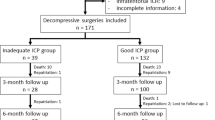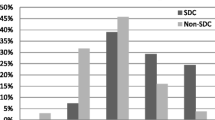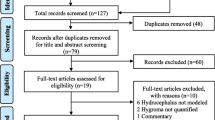Abstract
Purpose
Acute subdural haematoma (ASDH) is associated with severe traumatic brain injury and poor outcomes. Although guidelines exist for the decompression of ASDH, the question of adequate decompression remains unanswered. The authors examined the relationship of intracranial pressure (ICP) on closure with outcomes to determine its utility in the determination of adequate ASDH decompression.
Methods
A multicentre retrospective review of 105 consecutive patients with ASDH who underwent decompressive surgery was performed. Receiver operating characteristic (ROC) analysis with internal validation was performed to determine an ICP threshold for the division of patients into the inadequate and good ICP groups. Multivariable analyses were performed for both inpatient and long-term outcomes.
Results
An ICP threshold of 10 mmHg was identified with a 91.5% specificity, 45.7% sensitivity, and a positive and negative predictive value of 80.8% and 68.4%. There were 26 patients (24.8%) and 79 patients (75.2%) in the inadequate and good ICP groups, respectively. After adjustment, the inadequate ICP group was associated with increased postoperative usage of mannitol (OR 14.2, p < 0.001) and barbiturates (OR 150, p = 0.001). Inadequate ICP was also associated with increased inpatient mortality (OR 24.9, p < 0.001), and a lower rate of favourable MRS at 1 year (OR 0.08, p = 0.008). The complication rate was similar amongst the groups.
Conclusions
Closure ICP is a novel, objective, and actionable intraoperative biomarker that correlates with inpatient and long-term outcomes in ASDH. Various surgical manoeuvres can be undertaken to achieve this target safely. Large-scale prospective studies should be performed to validate this ICP threshold.



Similar content being viewed by others
References
Ashayeri K, Jackson EM, Huang J, Brem H, Gordon CR (2016) Syndrome of the trephined: a systematic review. Neurosurgery 79:525–534
Bullock MR, Chestnut R, Ghajar J et al (2006) Surgical management of acute subdural hematomas. Neurosurgery 58:S16–S24
Carney N, Totten AM, O’Reilly C et al (2017) Guidelines for the management of severe traumatic brain injury fourth edition. Neurosurgery 80:6–15
Charlson ME, Pompei P, Ales KL, MacKenzie CR (1987) A new method of classifying prognostic comorbidity in longitudinal studies: development and validation. J Chronic Dis 40:373–383
Copes WS, Champion HR, Sacco WJ, Lawnick MM, Keast SL, Bain LW (1988) The injury severity score revisited. J Trauma 28:69–77
d’Avella D, Servadei F, Scerrati M et al (2003) Traumatic acute subdural haematomas of the posterior fossa: clinicoradiological analysis of 24 patients. Acta Neurochir 145:1037–1044
Hanif S, Abodunde O, Ali Z, Pidgeon C (2009) Age related outcome in acute subdural haematoma following traumatic head injury. Ir Med J 102:255–257
Hatashita S, Koga N, Hosaka Y, Takagi S (1993) Acute subdural hematoma: severity of injury, surgical intervention, and mortality. Neurol Med Chir 33:13–18
Hawryluk GWJ, Aguilera S, Buki A et al (2019) A management algorithm for patients with intracranial pressure monitoring: the Seattle international severe traumatic brain injury consensus conference (SIBICC). Intensive Care Med 45:1783–1794
Hawryluk GWJ, Rubiano AM, Totten AM et al (2020) Guidelines for the management of severe traumatic brain injury: 2020 update of the decompressive craniectomy recommendations. Neurosurgery 87:427–434
Hlatky R, Valdaka AB, Goodman JC, Robertson CS (2007) Evolution of brain tissue injury after evacuation of acute traumatic subdural hematomas. Neurosurgery 61:249–254
Hutchinson PJ, Kolias AG, Tajsic T et al (2019) Consensus statement from the international consensus meeting on the role of decompressive craniectomy in the management of traumatic brain injury. Acta Neurochir 161:1261–1274
Ko K, Segan S (2007) In situ hinge craniectomy. Neurosurgery 60:255–258
Koc RK, Akdemir H, Oktem IS, Meral M, Menku A (1997) Acute subdural hematoma: outcome and outcome prediction. Neurosurg Rev 20:239–244
Kolias AG, Scotton WJ, Belli A et al (2013) Surgical management of acute subdural haematomas: current practice patterns in the United Kingdom and the Republic of Ireland. Br J Neurosurg 27:330–333
Kolias AG, Adams H, Timofeev I et al (2016) Decompressive craniectomy following traumatic brain injury: developing the evidence base. Br J Neurosurg 30:246–250
Li LM, Kolias AG, Guilfoyle MR et al (2012) Outcome following evacuation of acute subdural haematomas: a comparison of craniotomy with decompressive craniectomy. Acta Neurochir 154:1555–1561
Ling JM, Kee TP, Lee KK et al (2014) A decade of intracranial pressure –guided treatment of severe head injury. Neurosurgery 61(Suppl 1):212–213. https://doi.org/10.1227/01.neu.0000452435.44917.7f
Mahdavi ZK, Olson DM, Figueroa SA (2016) Association patterns of simultaneous intraventricular and intraparenchymal intracranial pressure measurements. Neurosurgery 79:561–567
Mangat HS, Wu X, Gerber LM et al (2020) Hypertonic saline is superior to mannitol for the combined effect on intracranial pressure and cerebral perfusion pressure burdens in patients with severe traumatic brain injury. Neurosurgery 86:221–230
Massaro F, Lanotte M, Faccani G (1996) Triolo C One hundred and twenty-seven cases of acute subdural haematoma operated one Correlation between scan findings and outcome. Acta Neurochir 138:185–191
Miller JD, Butterworth JF, Gudeman SK et al (1981) Further experience in the management of severe head injury. J Neurosurg 54:289–299
Morone PJ, Dewan MC, Zucherman SL, Tubbs RS (2020) Singer Rj Craniometrics and ventricular access: a review of Kocher’s Kaufman’s Paine’s Menovksy’s Tubbs’ Keen’s Frazier’s Dandy’s and Sanchez’s Points. Oper Neurosurg 18:461–469
Morris NA, Merkler AE, Parker WE et al (2016) Adverse outcomes after initial non-surgical management of subdural hematoma: a population-based study. Neurocrit Care 24:226–232
Park J, Lim E, Kim GY, Hur Y, Guthikonda M (2009) External decompressive craniectomy including resection of temporal muscle and fascia in malignant hemispheric infarction. J Neurosurg 110:101–105
Phan K, Moore JM, Griessenauer C et al (2017) Craniotomy versus decompressive craniectomy for acute subdural hematoma: systematic review and meta-analysis. World Neurosurg 101:677–685
Qiu B, Xu S, Fang L, Chotai S, Li W, Qi S (2012) Surgical strategies for neurological function preservation in severe brain contusion. Turk Neurosurg 22:329–335
Rangel-Castillo L, Gopinath S, Robertson CS (2008) Management of intracranial hypertension. Neurol Clin 26:521–541. https://doi.org/10.1016/j.ncl.2008.02.003
Schmidt JH, Reyes BJ, Fischer R, Flaherty SK (2007) Use of hinge craniotomy for cerebral decompression. J Neurosurg 107:678–682
Schur S, Martel P, Marcoux J (2020) Optimal bone flap size for decompressive craniectomy for refractory increased intracranial pressure in traumatic brain injury: taking the patient’s head size into account. World Neurosurg 137:e430–e436
Seelig JM, Becker DP, Miller JD, Greenberg RP, Ward JD, Choi SC (1981) Traumatic acute subdural hematoma: major mortality reduction in comatose patients treated within four hours. N Eng J Med 304:1511–1518
Servadei F, Nasi MT, Cremonini AM, Giuliani G, Cenni P, Nanni A (1998) Importance of a reliable admission Glasgow coma scale score for determining the need for evacuation of posttraumatic subdural hematomas: a prospective study of 65 patients. J Trauma 44:868–873
Shigemori M, Syojima K, Nakayama K et al (1980) The outcomes from acute subdural haematoma following decompressive hemicraniectomy. Acta Neurochir 54:61–69
Stiell I, Wells G, Vandemheen K et al (2001) The Canadian CT head rule for patients with minor head injury. Lancet 357:1391–1396
Tagliaferri F, Zani G, Iaccarino C et al (2012) Decompressive craniectomies, facts and fiction: a retrospective analysis of 526 cases. Acta Neurochir 154:919–926
Tallon JM, Ackroyd-Stolarz S, Karim SA, Clarke DB (2008) The epidemiology of surgically treated acute subdural and epidural hematomas in patients with head injuries: a population-based study. Can J Surg 51:339–345
Tan TK, Cheng MH, Sim EY (2015) Options for managing raised intracranial pressure. Proc Singapore Healthcare 24:156–164. https://doi.org/10.1177/2010105815598444
Taussky P, Widmer HR, Takala K, Fandino J (2008) Outcome after acute traumatic subdural and epidural haematoma in Switzerland: a single-centre experience. Swiss Med Wkly 138:281–285
Timofeev I, Santarius T, Kolias AG, Hutchinson PJA (2012) Decompressive craniectomy –operative technique and operative care. Adv Tech Stand Neurosurg 38:115–136
van Leeuwen N, Lingsma HF, Perel P et al (2012) Prognostic value of major extracranial injury in traumatic brain injury: an individual patient data meta-analysis in 39,274 patients. Neurosurgery 70:811–818
Volovici V, Huijben JA, Ercole A et al (2019) Ventricular drainage catheters versus intracranial parenchymal catheters for intracranial pressure monitoring-based management of traumatic brain injury: a systematic review and meta-analysis. J Neurotrauma 36:988–995
Wilberger JE, Harris M, Diamond DL (1991) Acute subdural haematoma: morbidity, mortality, and operative timing. J Neurosurg 74:212–218
Woertgen C, Rothoerl RD, Schebesch KM, Albert R (2006) Comparison of craniotomy and craniectomy in patients with acute subdural haematoma. J Clin Neurosci 13:718–721
Author information
Authors and Affiliations
Contributions
JXL and MWC contributed to study conception and design. Data collection was performed by SJL and TMC. Data analysis was performed by JXL, SES, and JXH. The manuscript draft was written by JXL, and all authors commented on previous versions of the manuscript. All authors read and approved the final manuscript.
Corresponding author
Ethics declarations
Ethics approval
thical approval was obtained prior to commencement of this study.
Conflict of interest
The authors declare no competing interests.
Additional information
Publisher's note
Springer Nature remains neutral with regard to jurisdictional claims in published maps and institutional affiliations.
This article is part of the Topical Collection on Brain trauma
Rights and permissions
About this article
Cite this article
Lim, J.X., Liu, S.J., Cheong, T.M. et al. Closure intracranial pressure is an objective intraoperative determinant of the adequacy of surgical decompression in traumatic acute subdural haematoma: a multicentre observational study. Acta Neurochir 164, 2741–2750 (2022). https://doi.org/10.1007/s00701-022-05270-2
Received:
Accepted:
Published:
Issue Date:
DOI: https://doi.org/10.1007/s00701-022-05270-2




